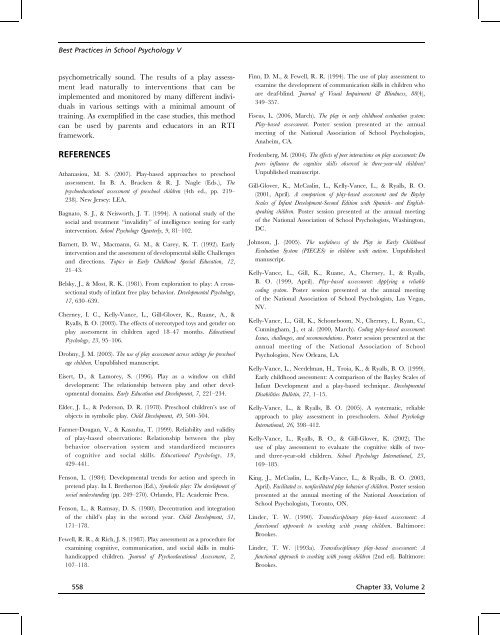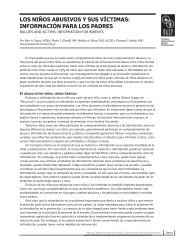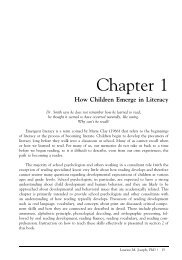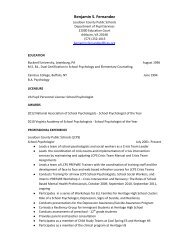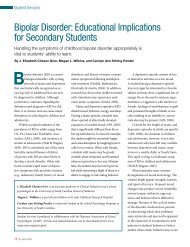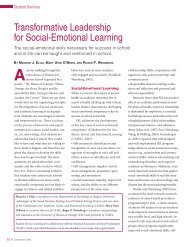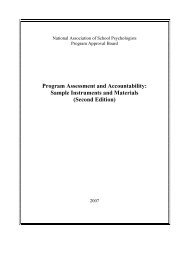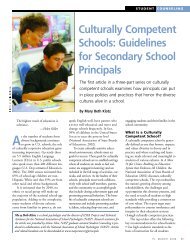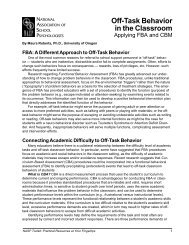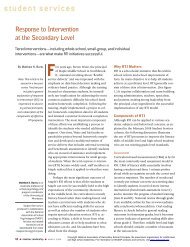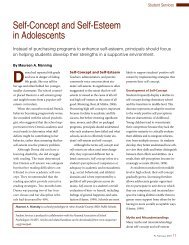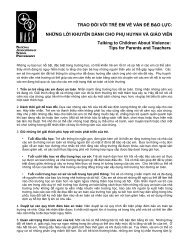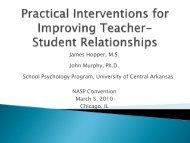Best Practices in Play Assessment and Intervention
Best Practices in Play Assessment and Intervention
Best Practices in Play Assessment and Intervention
You also want an ePaper? Increase the reach of your titles
YUMPU automatically turns print PDFs into web optimized ePapers that Google loves.
<strong>Best</strong> <strong>Practices</strong> <strong>in</strong> School Psychology V<br />
psychometrically sound. The results of a play assessment<br />
lead naturally to <strong>in</strong>terventions that can be<br />
implemented <strong>and</strong> monitored by many different <strong>in</strong>dividuals<br />
<strong>in</strong> various sett<strong>in</strong>gs with a m<strong>in</strong>imal amount of<br />
tra<strong>in</strong><strong>in</strong>g. As exemplified <strong>in</strong> the case studies, this method<br />
can be used by parents <strong>and</strong> educators <strong>in</strong> an RTI<br />
framework.<br />
REFERENCES<br />
Athanasiou, M. S. (2007). <strong>Play</strong>-based approaches to preschool<br />
assessment. In B. A. Bracken & R. J. Nagle (Eds.), The<br />
psychoeducational assessment of preschool children (4th ed., pp. 219–<br />
238). New Jersey: LEA.<br />
Bagnato, S. J., & Neisworth, J. T. (1994). A national study of the<br />
social <strong>and</strong> treatment ‘‘<strong>in</strong>validity’’ of <strong>in</strong>telligence test<strong>in</strong>g for early<br />
<strong>in</strong>tervention. School Psychology Quarterly, 9, 81–102.<br />
Barnett, D. W., Macmann, G. M., & Carey, K. T. (1992). Early<br />
<strong>in</strong>tervention <strong>and</strong> the assessment of developmental skills: Challenges<br />
<strong>and</strong> directions. Topics <strong>in</strong> Early Childhood Special Education, 12,<br />
21–43.<br />
Belsky, J., & Most, R. K. (1981). From exploration to play: A crosssectional<br />
study of <strong>in</strong>fant free play behavior. Developmental Psychology,<br />
17, 630–639.<br />
Cherney, I. C., Kelly-Vance, L., Gill-Glover, K., Ruane, A., &<br />
Ryalls, B. O. (2003). The effects of stereotyped toys <strong>and</strong> gender on<br />
play assessment <strong>in</strong> children aged 18–47 months. Educational<br />
Psychology, 23, 95–106.<br />
Drobny, J. M. (2003). The use of play assessment across sett<strong>in</strong>gs for preschool<br />
age children. Unpublished manuscript.<br />
Eisert, D., & Lamorey, S. (1996). <strong>Play</strong> as a w<strong>in</strong>dow on child<br />
development: The relationship between play <strong>and</strong> other developmental<br />
doma<strong>in</strong>s. Early Education <strong>and</strong> Development, 7, 221–234.<br />
Elder, J. L., & Pederson, D. R. (1978). Preschool children’s use of<br />
objects <strong>in</strong> symbolic play. Child Development, 49, 500–504.<br />
Farmer-Dougan, V., & Kaszuba, T. (1999). Reliability <strong>and</strong> validity<br />
of play-based observations: Relationship between the play<br />
behavior observation system <strong>and</strong> st<strong>and</strong>ardized measures<br />
of cognitive <strong>and</strong> social skills. Educational Psychology, 19,<br />
429–441.<br />
Fenson, L. (1984). Developmental trends for action <strong>and</strong> speech <strong>in</strong><br />
pretend play. In I. Bretherton (Ed.), Symbolic play: The development of<br />
social underst<strong>and</strong><strong>in</strong>g (pp. 249–270). Orl<strong>and</strong>o, FL: Academic Press.<br />
Fenson, L., & Ramsay, D. S. (1980). Decentration <strong>and</strong> <strong>in</strong>tegration<br />
of the child’s play <strong>in</strong> the second year. Child Development, 51,<br />
171–178.<br />
Fewell, R. R., & Rich, J. S. (1987). <strong>Play</strong> assessment as a procedure for<br />
exam<strong>in</strong><strong>in</strong>g cognitive, communication, <strong>and</strong> social skills <strong>in</strong> multih<strong>and</strong>icapped<br />
children. Journal of Psychoeducational <strong>Assessment</strong>, 2,<br />
107–118.<br />
F<strong>in</strong>n, D. M., & Fewell, R. R. (1994). The use of play assessment to<br />
exam<strong>in</strong>e the development of communication skills <strong>in</strong> children who<br />
are deaf-bl<strong>in</strong>d. Journal of Visual Impairment & Bl<strong>in</strong>dness, 88(4),<br />
349–357.<br />
Fiscus, L. (2006, March). The play <strong>in</strong> early childhood evaluation system:<br />
<strong>Play</strong>-based assessment. Poster session presented at the annual<br />
meet<strong>in</strong>g of the National Association of School Psychologists,<br />
Anaheim, CA.<br />
Fredenberg, M. (2004). The effects of peer <strong>in</strong>teractions on play assessment: Do<br />
peers <strong>in</strong>fluence the cognitive skills observed <strong>in</strong> three-year-old children?<br />
Unpublished manuscript.<br />
Gill-Glover, K., McCasl<strong>in</strong>, L., Kelly-Vance, L., & Ryalls, B. O.<br />
(2001, April). A comparison of play-based assessment <strong>and</strong> the Bayley<br />
Scales of Infant Development-Second Edition with Spanish- <strong>and</strong> Englishspeak<strong>in</strong>g<br />
children. Poster session presented at the annual meet<strong>in</strong>g<br />
of the National Association of School Psychologists, Wash<strong>in</strong>gton,<br />
DC.<br />
Johnson, J. (2005). The usefulness of the <strong>Play</strong> <strong>in</strong> Early Childhood<br />
Evaluation System (PIECES) <strong>in</strong> children with autism. Unpublished<br />
manuscript.<br />
Kelly-Vance, L., Gill, K., Ruane, A., Cherney, I., & Ryalls,<br />
B. O. (1999, April). <strong>Play</strong>-based assessment: Apply<strong>in</strong>g a reliable<br />
cod<strong>in</strong>g system. Poster session presented at the annual meet<strong>in</strong>g<br />
of the National Association of School Psychologists, Las Vegas,<br />
NV.<br />
Kelly-Vance, L., Gill, K., Schoneboom, N., Cherney, I., Ryan, C.,<br />
Cunn<strong>in</strong>gham, J., et al. (2000, March). Cod<strong>in</strong>g play-based assessment:<br />
Issues, challenges, <strong>and</strong> recommendations. Poster session presented at the<br />
annual meet<strong>in</strong>g of the National Association of School<br />
Psychologists, New Orleans, LA.<br />
Kelly-Vance, L., Needelman, H., Troia, K., & Ryalls, B. O. (1999).<br />
Early childhood assessment: A comparison of the Bayley Scales of<br />
Infant Development <strong>and</strong> a play-based technique. Developmental<br />
Disabilities Bullet<strong>in</strong>, 27, 1–15.<br />
Kelly-Vance, L., & Ryalls, B. O. (2005). A systematic, reliable<br />
approach to play assessment <strong>in</strong> preschoolers. School Psychology<br />
International, 26, 398–412.<br />
Kelly-Vance, L., Ryalls, B. O., & Gill-Glover, K. (2002). The<br />
use of play assessment to evaluate the cognitive skills of two<strong>and</strong><br />
three-year-old children. School Psychology International, 23,<br />
169–185.<br />
K<strong>in</strong>g, J., McCasl<strong>in</strong>, L., Kelly-Vance, L., & Ryalls, B. O. (2003,<br />
April). Facilitated vs. nonfacilitated play behavior of children. Poster session<br />
presented at the annual meet<strong>in</strong>g of the National Association of<br />
School Psychologists, Toronto, ON.<br />
L<strong>in</strong>der, T. W. (1990). Transdiscipl<strong>in</strong>ary play-based assessment: A<br />
functional approach to work<strong>in</strong>g with young children. Baltimore:<br />
Brookes.<br />
L<strong>in</strong>der, T. W. (1993a). Transdiscipl<strong>in</strong>ary play-based assessment: A<br />
functional approach to work<strong>in</strong>g with young children (2nd ed). Baltimore:<br />
Brookes.<br />
558 Chapter 33, Volume 2


